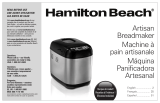
15
Frequently Asked Questions
May I use a sugar substitute in place of sugar?
Sugar is necessary for the yeast to produce a light loaf with a good
height. Results may vary with the type and amount of sugar substitute
used. If you are going to use an artificial sweetener, choose one that is
aspartame-based rather than saccharin-based.
May I omit the salt or sugar from the recipe?
No, both the sugar and salt play an important role in the breadmaking
process. Salt prevents the yeast from overreacting and the bread from
overrising. The combination of sugar, salt, and yeast is a key part of
the breadmaking process. Remember that the total sugar and salt
amounts are divided among all the slices, so the amount of sugar
and salt per serving is small.
When do I add raisins, nuts, etc., to the bread?
This breadmaker will beep at the start of the second kneading to let
you know when to add raisins, nuts, seeds, etc. This timing varies by
cycle. (Refer to the Timetable for Cycles chart.) If you are using the
Delay Start timer and it is more convenient, you may add ingredients
at the start.
Can I open the lid while the breadmaker is operating?
This breadmaker is designed with a window in the lid to let you watch
your bread’s progress. Quick checks are OK in the early stages of
kneading and to add ingredients when the beeper sounds. However,
the temperature in the baking chamber adjusts for the Rising and
Baking stages. Opening the lid during these steps could cause the loaf
to fall or not bake properly. Sometimes condensation forms on the
window after initial mixing and kneading. It usually disappears once
the baking cycle starts so you should be able to get a clear view of
your loaf.
Can I use my favorite bread recipes in my breadmaker?
Yes, but you will need to experiment to get the right proportion of
ingredients. Become familiar with the unit and make several loaves of
bread with recipes provided before you begin experimenting. Never
exceed a total amount of 4 1/4 (1 L) cups of dry ingredients (that
includes flours, oats, cornmeal, etc.). Use the recipes in this book to
help determine the ratio of dry ingredients to liquid and amounts of
yeast, sugar, salt, and butter/margarine to use.
What will happen if I leave the bread in the bread pan after baking?
This unit has a 60-minute Keep Warm cycle that lets you leave the
bread in the pan for up to an hour after baking is complete. Once the
warming cycle is over, it is best to remove the bread immediately or
the bottom of your loaf will absorb moisture and become soggy.
Can the recipe be cut in half?
No, it is not recommended. The ingredient proportions work better in
the full amounts.
How can bread mixes be used in the machine and at what setting?
The package instructions will list the amount of water and amount
of yeast to use. Be sure to add liquid, then dry ingredients, followed
by yeast. Do not allow the yeast to sit in the liquid. The bread type
setting is dependent upon the type of bread mix being used (i.e., White
bread uses the Basic bread setting; Sweet Bread setting is for use with
dried fruit, cheese, or nuts; whole-wheat or multigrain should use the
Whole Grain setting; Crust setting, either Light or Dark, is a personal
preference). Do not use bread mixes that exceed 2-lb. (907-g) loaf size.
What is the difference between American flour and Canadian Flour?
Canadian flour has a higher protein or gluten content than American
flour. You can substitute US flour in even amounts for Canadian flour.
However, Canadian flour may absorb more moisture. Check your
dough during the first kneading cycle. If it appears dry, you may add
up to 1 Tablespoon (15 ml) of additional water per cup of flour in the
recipe. Add the water 1 Tablespoon (15 ml) at a time until desired
consistency of a soft and supple dough is reached.
840194103 ENv04.indd 15840194103 ENv04.indd 15 12/15/14 4:18 PM12/15/14 4:18 PM




















